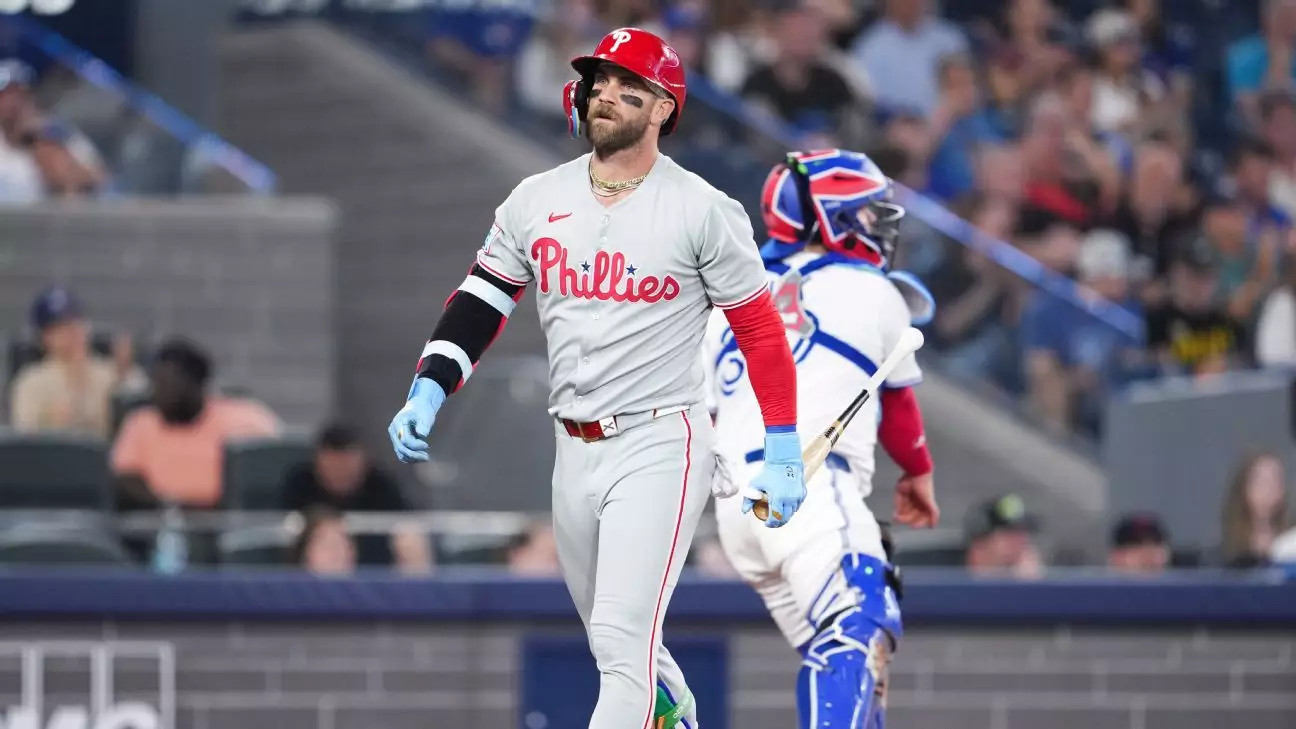Bryce Harper’s return to the Philadelphia Phillies’ lineup after a nearly monthlong hiatus due to persistent right wrist inflammation is emblematic of an athlete’s relentless resolve. While many players might opt for extended rest or cautious recovery periods, Harper has illustrated a mindset where playing at less than 100% is a preferable alternative to sitting on the sidelines. Despite a wrist that has caused discomfort since last season, Harper has maintained a level of performance that many would find commendable under such physical duress.
Typically, injuries like wrist inflammation are career saboteurs for hitters, especially those who rely on power and precise bat control. Harper’s ability to endure this pain speaks volumes about his toughness and commitment to his team. A two-time National League MVP and eight-time All-Star, Harper has never been one to shy away from the spotlight or the grind that comes with elite baseball. Instead, he embodies the competitive spirit that makes baseball a sport of perseverance as much as skill.
Statistical Impact and Team Dynamics
Statistically, Harper’s numbers this season—.258 batting average, nine home runs, 34 RBIs, and eight stolen bases through 57 games—may seem modest for a player of his caliber, but context is crucial. Playing through discomfort inevitably affects consistency and explosiveness at the plate. Notably, Harper endured an additional setback with a bruised right elbow from a pitch he suffered in late May, which further complicated his ability to perform at peak levels.
The Phillies’ performance without Harper—hovering just below .500 at 13-14—illustrates his undeniable value, even when not at full strength. Despite this, the team’s ability to retain leadership in the tough NL East division without him suggests a level of depth and resilience forged through strong management and emerging talent.
In Harper’s absence, rookie Otto Kemp seized the opportunity to showcase his versatility and potential—starting 20 out of 21 games, contributing 10 RBIs, and filling various defensive roles. His development provides the Phillies with a valuable asset, creating an intriguing balance between seasoned leadership and youthful promise within the roster.
Strategic Considerations for Harper’s Role
Harper’s return raises important tactical discussions for the Phillies’ management. His right wrist, while improved, remains a concern with playing time being managed cautiously and designated “day-to-day” based on how the wrist tolerates game action. The prospect of Harper playing first base—a position that imposes less physical strain than the outfield—is a strategic move allowing him to contribute offensively while minimizing the risk of aggravating the injury.
Another interesting element is the possibility of Harper serving as a designated hitter, a role currently thriving under Kyle Schwarber, whose 25 home runs bolster the Phillies’ lineup. This could provide Harper with crucial rest periods and reduce defensive workload, potentially prolonging his health over the grueling season.
The decision-making around roster adjustments has already been prompted, with infielder Buddy Kennedy designated for assignment to make room for Harper. This underscores the immediate value Harper brings to the team but also reflects the tough realities of professional sports where every roster spot counts and must be optimized.
Harper’s Leadership and Legacy Amid Adversity
More than stats and games played, Harper’s presence commands respect and inspiration within the Phillies clubhouse. His journey through injury and high-profile contract pressures reveals the mental toughness that often differentiates good players from great leaders. In the twilight of his prime, locked into a massive 13-year, $330 million contract, Harper still leads the team with an intensity that motivates a squad eager to chase postseason success.
Having been instrumental in the Phillies’ run to three consecutive playoff appearances, including their 2022 NLCS MVP performance, Harper bears the heavy burden of expectations. Yet, his candid acknowledgment that each day’s decision to play hinges on how his wrist feels demonstrates a realistic and mature approach to balancing personal health with team needs.
This nuanced perspective that blends persistence with pragmatism is what makes Harper more than just a power hitter—it shapes him as an ambassador of resilience in baseball. His ongoing tussle with injury highlights the human aspect of professional sports—a reminder that behind every highlight and home run, battles are often fought in silence off the field.


Leave a Reply